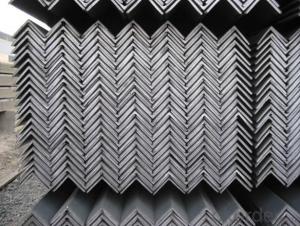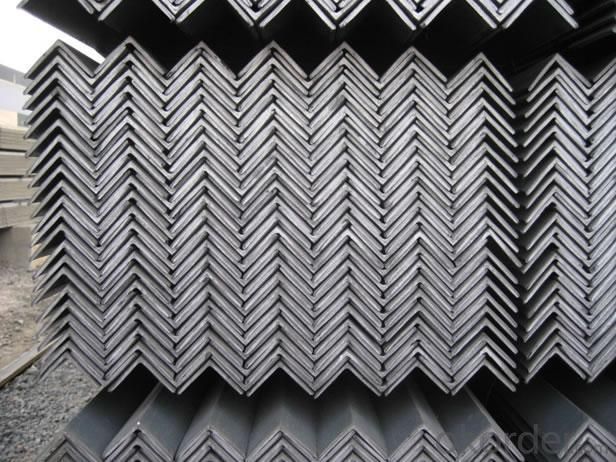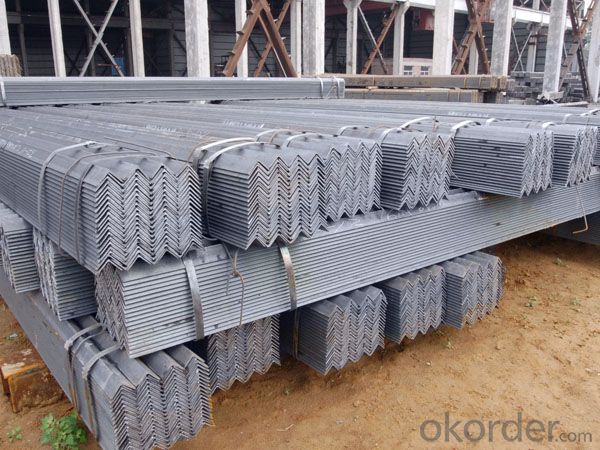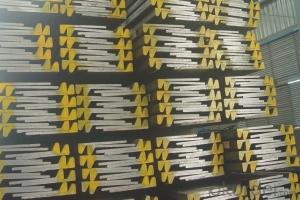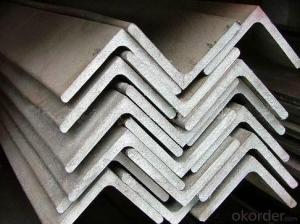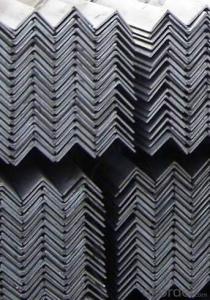Angle steel GB Q235B 20-250MM hot rolled
- Loading Port:
- Tianjin
- Payment Terms:
- TT OR LC
- Min Order Qty:
- 25 m.t.
- Supply Capability:
- 1000000 m.t./month
OKorder Service Pledge
OKorder Financial Service
You Might Also Like
Angle Steel Details:
| Minimum Order Quantity: | 25mtons | Unit: | m.t. | Loading Port: | China Main Port |
| Supply Ability: | 80000-100000MTS/YEAR | Payment Terms: | TT or LC |
Product Description:
Specifications of Angle Steel
1. Invoicing on theoretical weight or actual weight as customer request
2. Length: 6m, 9m, 12m as following table
3. Sizes

Sizes: 25mm-250mm | ||
a*t | ||
25*2.5-4.0 | 70*6.0-9.0 | 130*9.0-15 |
30*2.5-6.6 | 75*6.0-9.0 | 140*10-14 |
36*3.0-5.0 | 80*5.0-10 | 150*10-20 |
38*2.3-6.0 | 90*7.0-10 | 160*10-16 |
40*3.0-5.0 | 100*6.0-12 | 175*12-15 |
45*4.0-6.0 | 110*8.0-10 | 180*12-18 |
50*4.0-6.0 | 120*6.0-15 | 200*14-25 |
60*4.0-8.0 | 125*8.0-14 | 250*25 |
5. Payment terms:
1).100% irrevocable L/C at sight.
2).30% T/T prepaid and the balance against the copy of B/L.
3).30% T/T prepaid and the balance against L/C
6.Material details:
Alloy No | Grade | Element (%) | |||||
C | Mn | S | P | Si | |||
|
|
|
|
|
|
| |
Q235 | B | 0.12—0.20 | 0.3—0.7 | ≤0.045 | ≤0.045 | ≤0.3 | |
|
|
|
|
|
|
| |
Alloy No | Grade | Yielding strength point( Mpa) | |||||
Thickness (mm) | |||||||
≤16 | >16--40 | >40--60 | >60--100 | ||||
≥ | |||||||
|
|
|
|
|
| ||
Q235 | B | 235 | 225 | 215 | 205 | ||
Alloy No | Grade | Tensile strength (Mpa) | Elongation after fracture (%) | ||||
Thickness (mm) | |||||||
| ≤16 | >16--40 | >40--60 | >60--100 | |||
≥ | |||||||
|
|
|
|
|
|
| |
Q235 | B | 375--500 | 26 | 25 | 24 | 23 | |
Usage & Applications of Angle Steel
According to the needs of different structures, Angle can compose to different force support component, and also can be the connections between components. It is widely used in various building structures and engineering structures such as roof beams, bridges, transmission towers, hoisting machinery and transport machinery, ships, industrial furnaces, reaction tower, container frame and warehouse etc.
Packaging & Delivery of Angle Steel
1. Packing: it is nude packed in bundles by steel wire rod
2. Bundle weight: not more than 3.5MT for bulk vessel; less than 3 MT for container load
3. Marks:
Color marking: There will be color marking on both end of the bundle for the cargo delivered by bulk vessel. That makes it easily to distinguish at the destination port.
Tag mark: there will be tag mark tied up on the bundles. The information usually including supplier logo and name, product name, made in China, shipping marks and other information request by the customer.
If loading by container the marking is not needed, but we will prepare it as customer request.
Production flow of Angle Steel
Material prepare (billet) —heat up—rough rolling—precision rolling—cooling—packing—storage and transportation
- Q:Can steel angles be drilled or cut?
- Yes, steel angles can be drilled or cut using appropriate tools and techniques.
- Q:How do you calculate the moment capacity of a steel angle?
- To calculate the moment capacity of a steel angle, several factors need to be considered. Firstly, the geometry of the angle needs to be determined, including the dimensions of the flanges and the web. The width of the flanges (b) and the thickness of the flanges (tf) and the web (tw) are crucial parameters. Next, the yield strength of the steel material needs to be known. This value represents the stress level at which the steel begins to permanently deform. It can be obtained from the material specifications or testing. The moment capacity of a steel angle can then be calculated using the following equation: Mn = Z × Fy Where: Mn is the moment capacity of the angle (in lb-ft or N-m) Z is the plastic section modulus of the angle (in^3 or mm^3) Fy is the yield strength of the steel material (in psi or MPa) The plastic section modulus (Z) is a measure of the shape's resistance to bending. It can be found in reference tables or calculated using equations specific to the angle's geometry. Once the values for Z and Fy have been determined, they can be plugged into the equation to calculate the moment capacity (Mn) of the steel angle. It is important to note that this calculation assumes elastic behavior of the steel angle and does not account for factors such as strain hardening or local buckling. Additionally, it is crucial to check the calculated moment capacity against the design requirements and safety factors to ensure the angle is suitable for the intended application.
- Q:Can steel angles be used for framing or supporting exterior façade elements?
- Yes, steel angles can be used for framing or supporting exterior façade elements. Steel angles are commonly used in construction for their strength and durability. They provide a stable and reliable support system for various architectural elements, including exterior façade elements. Steel angles can be used to frame windows, doors, and other openings in the exterior walls. They can also be used to reinforce and support the weight of exterior cladding materials such as stone, glass, or metal panels. Steel angles are versatile and can be easily customized to fit the specific requirements of the project. They are often preferred in commercial and industrial buildings where structural stability is of utmost importance.
- Q:Can steel angles be used for manufacturing balcony structures?
- Yes, steel angles can be used for manufacturing balcony structures. Steel angles are commonly used in construction due to their strength and durability. They provide structural support and stability, making them suitable for balcony structures. Steel angles are often used as support beams or framing components in balcony construction, providing a solid base for the balcony's flooring and railing. Additionally, steel angles can be easily fabricated and customized to meet specific design requirements, making them a versatile choice for balcony manufacturing.
- Q:What are the different methods for reinforcing steel angles?
- There are several methods for reinforcing steel angles, depending on the specific structural needs and design requirements. Some of the common methods include: 1. Welding: This is the most commonly used method for reinforcing steel angles. Welding involves joining two or more steel angles together using heat and pressure to create a strong and durable connection. It is important to ensure proper welding techniques and procedures are followed to maintain the integrity of the reinforcement. 2. Bolting: Another method for reinforcing steel angles is through the use of bolts. Bolts are inserted through holes in the angles and tightened to create a secure connection. This method is often used when the reinforcement needs to be adjustable or removable. 3. Riveting: Riveting is a traditional method for reinforcing steel angles. It involves inserting a pin or rivet through holes in the angles and securing it by deforming the end of the pin. This creates a strong and permanent connection between the angles. 4. Adhesive bonding: In some cases, adhesive bonding can be used to reinforce steel angles. This method involves applying a special adhesive to the surfaces of the angles and then pressing them together. The adhesive hardens and forms a strong bond between the angles. 5. Plate strengthening: When additional reinforcement is required, steel plates can be attached to the angles. These plates are typically welded or bolted to the angles to increase their strength and load-bearing capacity. 6. Reinforcing bars: Reinforcing bars, commonly known as rebar, can be used to reinforce steel angles. These bars are typically embedded into the concrete or masonry structure and extend into the angles to provide additional strength and support. It is important to consult with a structural engineer or design professional to determine the most appropriate method for reinforcing steel angles based on the specific project requirements and structural considerations.
- Q:What are the different types of connections used for steel angles?
- There are several types of connections used for steel angles, including bolted connections, welded connections, and riveted connections.
- Q:Can steel angles be used for railings or barriers?
- Yes, steel angles can be used for railings or barriers. Steel angles provide structural support and stability, making them suitable for creating sturdy railings and barriers.
- Q:How do steel angles resist corrosion?
- Steel angles resist corrosion through a process called passivation. Passivation is the formation of a protective layer on the surface of the steel that acts as a barrier against corrosive elements such as moisture, oxygen, and chemicals. Steel angles are typically made from stainless steel, which contains a minimum of 10.5% chromium. Chromium is a key element that enables the formation of a thin, invisible layer of chromium oxide on the surface of the steel. This oxide layer is highly stable and prevents further corrosion from occurring. The chromium oxide layer acts as a physical barrier, protecting the underlying steel from the corrosive effects of the environment. It is also self-healing, meaning that if the oxide layer is damaged or scratched, it will naturally reform and restore its protective properties. Additionally, stainless steel angles may contain other alloying elements such as nickel and molybdenum, which further enhance their corrosion resistance. These elements contribute to the formation of a more stable oxide layer and provide additional protection against localized corrosion, such as pitting and crevice corrosion. Furthermore, steel angles can be treated with various surface finishes or coatings to enhance their resistance to corrosion. These treatments can include processes like hot-dip galvanizing, electroplating, or applying organic coatings. These additional layers act as an extra barrier, preventing corrosive substances from reaching the steel surface. Overall, steel angles resist corrosion by forming a protective layer of chromium oxide on their surface, which acts as a barrier against corrosive elements. The inclusion of other alloying elements and the application of surface treatments further enhance their ability to withstand corrosion in various environments.
- Q:What is hot dip galvanized steel angle?
- The steel parts after rust removal are immersed in molten zinc at about 500 degrees of temperature, so that the zinc coating is adhered on the surface of the steel members so as to achieve the purpose of corrosion protection. Hot galvanizing process: finished Pickling - washing - plating solution - drying - hanging - cooling - drug - Cleaning - grinding - finishing hot galvanizing
- Q:Can steel angles be used in temporary or modular structures?
- Yes, steel angles can be used in temporary or modular structures. Steel angles are commonly used in construction due to their strength, versatility, and cost-effectiveness. They are often used to provide structural support and stability in various applications, including temporary or modular structures. Steel angles can be easily cut, welded, and bolted, making them suitable for assembling and disassembling temporary or modular structures. Additionally, steel angles can withstand heavy loads and provide excellent resistance against bending and twisting forces, ensuring the stability and safety of the structure.
1. Manufacturer Overview |
|
|---|---|
| Location | |
| Year Established | |
| Annual Output Value | |
| Main Markets | |
| Company Certifications | |
2. Manufacturer Certificates |
|
|---|---|
| a) Certification Name | |
| Range | |
| Reference | |
| Validity Period | |
3. Manufacturer Capability |
|
|---|---|
| a)Trade Capacity | |
| Nearest Port | |
| Export Percentage | |
| No.of Employees in Trade Department | |
| Language Spoken: | |
| b)Factory Information | |
| Factory Size: | |
| No. of Production Lines | |
| Contract Manufacturing | |
| Product Price Range | |
Send your message to us
Angle steel GB Q235B 20-250MM hot rolled
- Loading Port:
- Tianjin
- Payment Terms:
- TT OR LC
- Min Order Qty:
- 25 m.t.
- Supply Capability:
- 1000000 m.t./month
OKorder Service Pledge
OKorder Financial Service
Similar products
New products
Hot products
Hot Searches
Related keywords
